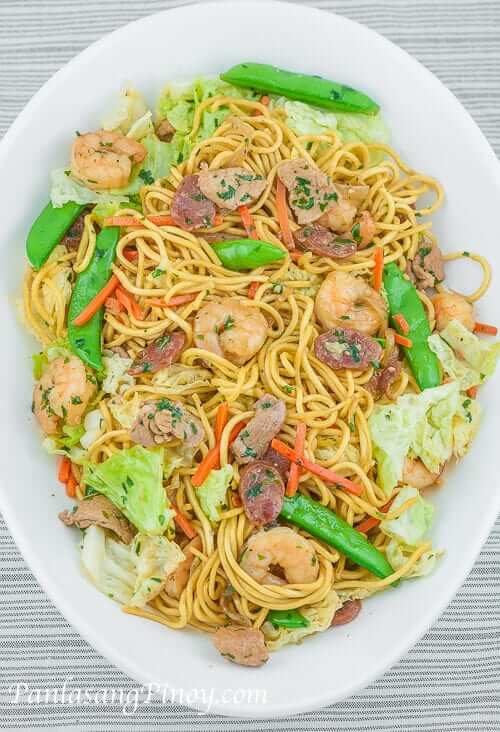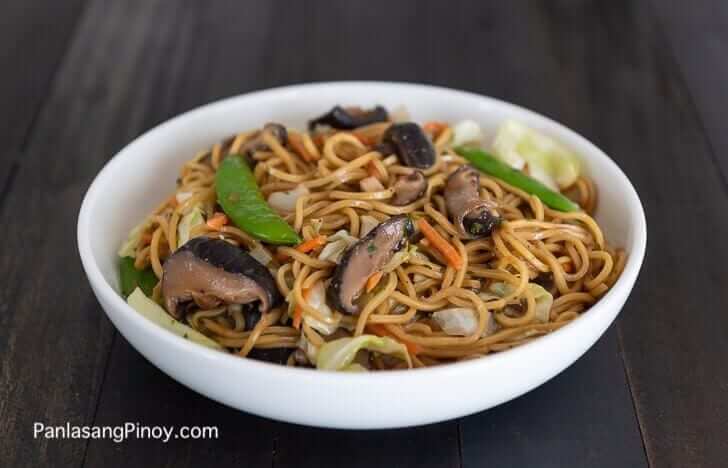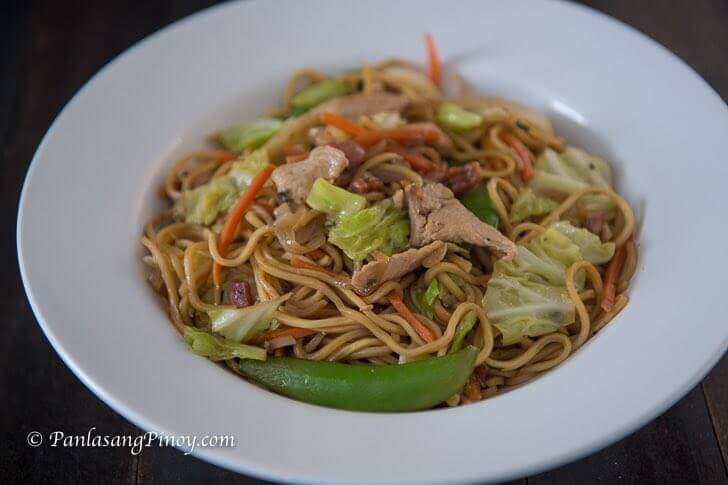Filipino Pancit Recipe
Pancit is a popular Filipino dish made from noodles, vegetables, and various proteins like chicken, pork, or shrimp. It has its origins in the Hokkien Chinese word “pian iat,” which means “flat noodles.” The term was adapted into the Filipino language to refer to nearly all stir-fried noodles coated in sauce. In this recipe, the…
This post may contain affiliate links. Please read our disclosure policy.
Pancit is a popular Filipino dish made from noodles, vegetables, and various proteins like chicken, pork, or shrimp. It has its origins in the Hokkien Chinese word “pian iat,” which means “flat noodles.” The term was adapted into the Filipino language to refer to nearly all stir-fried noodles coated in sauce. In this recipe, the pancit noodles that we’re going to use are rice noodles (bihon) and egg noodles (canton). If you’re wondering how to cook it and make it extra delicious, follow this recipe!

Pancit!
Most Filipino pancit recipes include common ingredients, like cabbage and carrots for vegetables, and pork and chicken for meat, all seasoned with sauce. Once the vegetables and meat are cooked, they are tossed with the noodles to create a dish that has become a key part of Filipino celebrations and daily meals.
How To Cook Filipino Pancit
- Sauté the garlic, onion, and pork – Begin by heating the cooking oil in a large wok over medium heat. Once the oil is hot, sauté the minced garlic and chopped onion until they soften and become fragrant. Next, add the sliced pork belly and cook, stirring occasionally, until it turns light brown. This step ensures the pork develops flavor and a slightly crispy texture.
- Create the Savory Sauce – Pour in the soy sauce and stir to combine with the pork. Add the oyster sauce and water, bringing everything to a boil. Cover the wok and let it simmer for about 20 minutes, or until the pork becomes tender. Make sure to check the liquid level and add more water if needed to prevent the mixture from drying out.
- Add Vegetables and Seasoning – Once the pork is tender, dissolve the Maggi Magic Chicken Cube into the sauce. Then, add the carrots and chopped cabbage. Stir and cook for about a minute to allow the vegetables to soften slightly while absorbing the flavors.
- Incorporating Noodles – Add the pancit bihon and pancit canton into the wok. Ensure the noodles are fully immersed in the sauce, allowing them to soak up the flavor. Continue to cook, stirring occasionally, until the noodles soften and are evenly coated with the sauce.
- Final Touches and Serving – Sprinkle with chopped parsley and season with ground black pepper and a dash of fish sauce for extra flavor. Cover the wok and let everything simmer for another 3 minutes. Finally, turn off the heat, transfer the Filipino pancit to a serving plate, and serve hot. Enjoy this savory, flavorful dish with family and friends!
Did you know…pancit was the first takeout food in the Philippines?
Chinese food hawkers during the Spanish era would sell pancit to factory workers upon going to work (as their work meal) and towards the end of the day (to bring home to their family for dinner). History books mention the existence of Pancit in the Philippines in a early as the 16th century.

Tips and Tricks
Noodles
- You can use any pancit noodle variety for this recipe. The most common are bihon (rice stick), canton (flour noodles), and sotanghon (Asian vermicelli).
- Feel free to combine the noodles together. Usually 2 types of pancit noodles are mixed: bihon and canton (which is this recipe), and sotangon and canton (this is also called Pancit Bam-i).
- There are more than one way to prepare your noodles. For bihon and sotanghon, soak it in water for 10 to 12 minutes or until soft before sauteeing. This is the preparation for pancit guisado. You can also opt to add these noodles without soaking. Simply add noodles while the broth boils and then toss until the desired consistency is reached. For flour and egg noodles (pancit canton). It can be boiled separately for 2 minutes before cooking, and it can also be added to the boiling broth similar to the other pancit varieties.
Vegetables
- The most common vegetables used for pancit are carrots and cabbage. Feel free to add scallions, bell peppers, wood ear mushroom, parsley, and bok choy.
- The vegetables can be added to the boiling broth (this will happen before you add the noodles), or you can cook these separately by steaming, blanching, or partially stir-frying.
Protein
- Chicken and pork are common ingredients in pancit. You can use either or both.
- Shrimp can also be added to your dish. This makes the dish special.
- For added flavor, try incorporating Chinese sausage. Saute this with the aromatics in the beginning of the cooking process.
What to serve with pancit
New readers that are not that familiar with Filipino cuisine have been asking me on how to enjoy pancit better. I email back by telling them what I usually have with my pancit that I enjoy the most. Maybe you can help me add more to the list?
- Pandesal – the most common among Filipino breads has been a staple in the Philippines. Most people, including myself, love to have this with pancit. You can have it side-by-side or make some sort of pancit sandwich like I do.
- Fried egg topped over your pancit can make it more enjoyable. I suggest to cook the egg over easy so that you can combine the yolk with the noodles. Toss it for a richer flavor.
- Calamansi or calamondin is a must have condiment for any variety of pancit.
- Soy sauce is also a widely used condiment. I like it best when soy sauce is mixed with calamansi (also known as toyomansi ot the Filipino version of Ponzu).
- Puto or Filipino steamed rice cake is a good option too.
What are the other versions of pancit?
There are over 20 regional varieties of pancit. Each of this are adapted by the location or region that it originated from. When compared side by side, obvious differences can be spotted with the type of noodles used to the sauce added to the pancit. Other varieties can be almost identical in terms of appearance, but it differs in preparation and flavor. Here are these different ways to make pancit.

Sides for Pancit
This noodle dish should be good to go without any sides at all. Well, the variety of ingredients makes it a combination of side dishes (I think). However, if there will be sides for my pancit, then these are the ones that I recommend.
- Lumpia – most people that I know (including myself – I think that I am knowing myself better now as I age) will agree that lumpia or Lumpiang Shanghai is the number one side dish for pancit. This is the the perfect pairing, so to speak. Do you feel the same way?
- Okoy – this can come in different varieties. The most common are shrimp fritters and vegetable fritters. I like to have these with my pancit as long as I can enjoy it crispy. I like the contrast of texture between the noodles and the crispy okoy batter.
- Sauteed broccoli and cauliflower is a good light side dish. You can also steam it so that it will not be too oily.
- Fried Pork Belly (Lechon kawali) – also provides that contrast of texture (between the soft noodles and crunchy pork skin). In fact, there are regional pancit varieties that make use of this as a topping.
Did you make this? If you snap a photo, please be sure tag us on Instagram at @panlasangpinoy or hashtag #panlasangpinoy so we can see your creations!

Pancit
Ingredients
- 1/2 lb pancit bihon
- 1/2 lb pancit canton
- 1/2 lb. pork belly sliced
- 1 cup carrot
- 1/2 small cabbage chopped
- 1 onion chopped
- 1/2 tbsp garlic minced
- 1/2 cup parsley chopped
- 1 Maggi Magic Chicken Cube
- 1/4 cup soy sauce
- 2 tablespoons oyster sauce
- 4 cups water
- 3 tbsp cooking oil
- Ground black pepper and fish sauce to taste
Instructions
- Heat the oil in a large wok. Sauté garlic and onion.1/2 tbsp garlic minced, 3 tbsp cooking oil, 1 onion chopped
- Add the pork. Sauté until it turns light brown.1/2 lb. pork belly
- Pour the soy sauce and then add oyster sauce and water. Let boil. Cover the wok. simmer for 20 minutes or until the pork becomes tender. Note: add water as needed.1/4 cup soy sauce, 2 tablespoons oyster sauce, 4 cups water
- Add Maggi Magic Chicken Cube, carrots, and cabbage. Stir and cook for 1 minute.1 cup carrot, 1 Maggi Magic Chicken Cube, 1/2 small cabbage chopped
- Add the pancit bihon and canton. Let it soak completely in the sauce. Continue cooking until the noodles are soft enough to be tossed.1/2 lb pancit bihon, 1/2 lb pancit canton
- Gently toss the noodles until all the ingredients are well distributed.
- Add parsley, and then season with ground black pepper and fish sauce.1/2 cup parsley, Ground black pepper and fish sauce to taste
- Cover the wok. Simmer for 3 minutes.
- Turn the heat off. Transfer to a serving plate.
- Serve hot. Share and enjoy!
Notes
- 1/2 lb pancit bihon – These are thin rice noodles. They absorb the flavor of the sauce and give the dish its signature texture. It’s essential to soak them briefly before cooking to prevent them from becoming too soft or soggy.
- 1/2 lb pancit canton – These are egg noodles that add a slightly chewy texture to the dish. They hold up well when stir-fried and provide a firmer bite compared to bihon. Be careful not to overcook them as they can become too soft.
- 1/2 lb pork belly, sliced – Adds depth to the dish, with its fat contributing to the savory taste. Slicing it thinly helps it cook quickly and evenly.
- 1 cup carrot – Bring color, sweetness, and crunch to the dish. They should be sliced thinly or julienned to ensure they cook through without losing their crunch.
- 1/2 small cabbage, chopped – Adds a mild flavor and a bit of crunch. It’s important to chop it into small pieces so it cooks evenly.
- 1 onion, chopped – An essential aromatic foundation of the dish.
- 1/2 tbsp garlic, minced – Minced garlic releases more of its oils, enhancing the flavor.
- 1/2 cup parsley, chopped – Adds color and a burst of freshness.
- 1 Maggi Magic Chicken Cube – It’s a shortcut to achieving a richer flavor profile. Without it, the pancit would taste less savory and require more seasoning adjustments.
- 1/4 cup soy sauce – Adds saltiness, balancing the dish’s sweetness and richness.
- 2 tablespoons oyster sauce – Adds a mild sweetness and umami flavor to the dish. It also gives a glossy finish.
- 4 cups water – The base liquid used to cook the noodles and combine all the ingredients.
- 3 tbsp cooking oil – Helps cook the vegetables and protein.



Leave a Comment